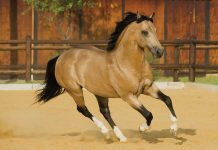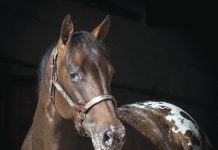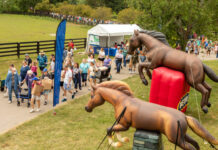
Pleasure Classes
In pleasure classes, only the horse is judged. But this doesn’t mean you should slump over in the saddle and look like a sack of potatoes; it means you should be more aware of what your horse is doing, rather than making sure your equitation is perfect.
A pleasure horse should literally be “a pleasure to ride.” The most important thing a pleasure horse can have is manners! He needs to be willing, obedient, and sound. He should get his correct leads when you ask for them and be able to travel in a straight line down the rail — no weaving around here!
He should be very safe and “fit” the rider, meaning that a super-tall rider shouldn’t be riding a small pony!
An English pleasure class is suitable for all horses that can walk, trot and canter in both directions of the arena. This class spotlights the horse that moves the most willingly and evenly — he doesn’t have to be the best mover.
The English pleasure horse shouldn’t pull on the reins or refuse to go forward. He needs to be quiet, safe and obedient. You can ride on a loose rein or rein contact in an English pleasure class and not be penalized.
Hunter Under Saddle
In this class, your horse walks, trots and canters in both directions around the arena and is judged on how well he moves (his “way of going”) and carries himself at all three gaits.
Though good manners are important, they are not judged as heavily as in a pleasure class. Rein contact is required and horses are judged more on their “type” than in pleasure classes.
Hunter under saddle horses are usually required to hand gallop in groups of eight in one direction of the ring, usually counter-clockwise.
Bridle Path Hack or Road Hack
This is a basic flat class that can also include extended trot and hand galloping in at least one direction around the arena. The judge may also ask for your horse to halt and back up.
Go As You Please
In a “go as you please” class, the horse is judged at a walk and at one other gait. This “other” gait must be the same both ways of the ring. You want to show off your horse’s best gait!
English Equitation
Equitation classes are a little different. Instead of judging the horse, the judge will judge you and how well you can control your horse–not how well your horse moves.
The main focus is on how you ride, but the judge will notice if your horse runs away with you or if he’s so lazy you have to kick him around the arena. Bad behavior by your horse can cost you a ribbon — even in an equitation class.
The judge will focus mainly on your leg position, your upper body position, your posture, your hand position and your overall horsemanship. She’ll also watch to see if you are on the correct trot diagonal and canter lead.
The judge will also take into account how promptly your horse responds to your cues and how accurate your movements are. For example, if you’re asked to trot a figure eight, are both circles even and equal in size?
She’ll note how you interact with the other riders and horses in the ring–are you cutting off people or riding too closely to another horse? She’ll also look at how neat and tidy you look.
In English equitation you’ll be asked to perform a test. This is simply a challenge to complete in the arena that helps the judge decide which of you in the class deserves to be first. This ridden test can include a change of diagonal, a canter transition (make sure you get the proper lead!) and possibly a halt and a back up.
Ring Savvy
In all of these flat classes there are ways to make you and your horse stand out from the crowd.
Before you even enter the ring, make sure that you’re clean and presentable, your horse’s mane is laying flat and he has a fresh coat of polish on his hooves.
When you enter the ring, leave enough room between you and the horse in front of you so that the judge has time to look at you and write down your number as you enter, turn and begin to travel down the rail (the arena fence).
Hold your head high and smile to show the judge how much you enjoy showing your horse and what a pleasure he is to ride.
Always keep a safe distance (at least three horse lengths) between you and the horse in front of you. Try not to get caught on the rail and have a horse on the inside covering you up when you ride by the judge — you want to be sure that she sees you and your fabulous horse!
If your horse is going faster than the horse in front of him, leave enough room to pass him safely and don’t ride up on his rear—he might kick you or your horse.
When you’re asked to canter, try to ask for the lead in the corner, where you’re more likely to get the correct lead. If you know your horse has trouble with one lead in particular, really set him up for it and ask strongly.
If you do get the wrong lead, immediately bring him back to a trot and ask again. There’s a good chance that the judge didn’t even see you! With only one set of eyes and multiple horses in the class, she can miss quite a few mistakes, so don’t panic if you have a small error, just fix it and continue on like it didn’t even happen.
If you’re doing a test and you pick up the wrong lead, you’ll gain more points with the judge if you stop and try again, rather than continuing around the arena on the wrong lead. By breaking, you show the judge that you know you are on the incorrect lead and you want to get the correct one.
If you get stuck in a traffic jam on the rail, try to get out of it, or avoid it entirely if you can. It is always best to try to stay away from large group of horses, so circle to get away from them. This is called “ring savvy.”
Most importantly, if you don’t win or get the placing you feel you deserve, don’t pout and cause a scene. Creating a ruckus is the best way for the judge to remember you – and not in a good way! Congratulate the winners and walk out of the ring.
This article first appeared in the July/August 2005 issue of Young Rider. Click here to subscribe!




